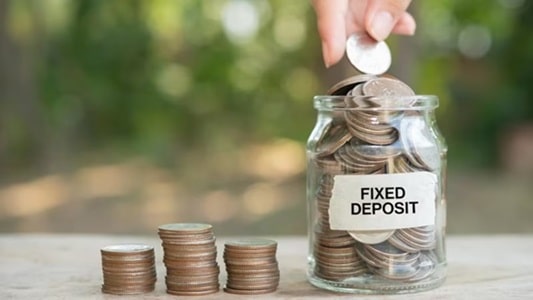Let’s be clear from the get-go, you see, it is a type of savings account called a Fixed Deposit (FD) Account that banks and non-banking financial companies (NBFCs) offer. You put a lump sum of money into this account, and the money stays there for a set amount of time and earns a set amount of interest. Simple as that! You can take money out of a regular savings account whenever you want but with an FD account. The money in an FD is locked in for as long as you choose. It could be a few days or a few years. Alright, now you have your basics right, let’s get to the actual stuff, you know, the benefits and downsides of a Fixed Deposit account. Here we go.

Advantages of Fixed Deposit (FD) Account
1. Super Safe
See, FDs are more of a safe option compared to other account types and financial services. They don’t go up and down with the market like stocks and mutual funds do, so you know what you are getting yourself into. If you put money into an FD, you can’t get it back, well, right away, you know? And again, your interest rate stays the same no matter what the market does. All in all, FD accounts are great for people who want to play it not just safer, but super safe.
2. Set Time, Set Returns
FDs are famous for those set lengths of time, you know, which can be anywhere from 7 days to 10 years. You choose the amount of time that works best for your money goals. From the first day, the interest rate has been set and will stay that way. All in all, you know exactly what you’re getting, which helps you make better financial plans. For example, if you’re saving for your child’s college or a down payment on a house, you can time the maturity of your FD to match the timing of your goal and know exactly how much you’ll have in your hands when it matures.
3. Emergency Cash Ready
If you ever need money quickly, one of the best things about FDs is that you can borrow against them. Yes, that’s true! Sure, you can’t break an FD account, but what you can do is take a loan against it, and that too, with a cheaper interest rate. Keep in mind though, the amount you can borrow is up to 95% of the amount in your FD.
4. Flexible Interest Payouts
You can get interested in FDs in a number of different ways. You can get it every month, every three months, every year, or all at once when the FD matures. Now, that’s what we call flexible, right? If you want your FD to pay you interest every single month, well, you sure can do that, with no issues at all. Though, it would be better to read through the terms and conditions of the bank before you jump ahead and open an FD account with them.
5. Easy-Peasy Management
You see, it is very or super easy to start, renew, or close an FD online with most banks. You can also easily put the money from the maturity into a new FD. Yes, all that can be done online, without even stepping a foot in your bank branch.
6. Tax Benefits
Let’s be clear, FDs are counted in taxable income, so yes, there will be tax code applied, but the best thing about FD accounts is that there is a tax cap that lowers the tax burden overall. Interest income up to INR 40,000 (INR 50,000 for older citizens) is not subject to tax deduction at source (TDS) at the moment in the country. So, that’s that.
Disadvantages of Fixed Deposit (FD) Account
1. Low Returns, Though, Not Exactly a Goldmine
Sure, FDs do promise returns, but the interest rates are generally lower than those on stocks, mutual funds, real estate groups, and other investments that are tied to the market. And if you know anything about inflation, you’d be able to speculate pretty easily that your FD money won’t be able to keep up with the rising inflation as compared to other investment opportunities. So, that’s a pretty considerable downside in our opinion.
2. Early Withdrawal Penalties
If you want to break the FD before it is even matured, you’ll have to pay a fee for that and trust us, you wouldn’t like that at all. That’s why there are options like taking a loan against your FD, which we already talked about in the positives of FD accounts. And yes, some banks even charge a flat fee, which makes taking money out early even less appealing.
3. No Full Tax Break Here
It might be a bit hard to understand for first-timers, but get this: the interest you earn on FDs gets added to your taxable income and is taxed according to your income tax slab. Which simply means, there is a limit on how much interest income is not subject to TDS. And yes, it can be annoying that you can’t get a full tax break, especially if you’re in a higher tax slab.
4. Fixed Interest Rates
No matter what happens to market rates, FD interest rates stay the same for the whole term. This can be exactly what you are looking for, but you are likely to regret it in the long run because other investment options could have earned you more in interest earnings.
5. Locked-In Funds
If you put money into an FD, you can’t get it out for as long as you want. You can’t get to your money without being charged fees because of this lack of liquidity, you know, which can be a big problem if you need money quickly. FDs don’t let you take money out without you first paying the fees, unlike savings accounts or other liquid investments. Believe it or not, this is one of the major factors that keeps a lot of people away from investing their money or locking their money in an FD account.
Quick Comparison Between Advantages and Disadvantages of Fixed Deposit (FD) Account
|
Advantages |
Disadvantages |
| Very safe investment | Lower returns compared to other investments |
| Fixed duration and returns | Penalties for early withdrawal |
| Loan options available against FD | Interest income taxable |
| Flexible interest payouts | Fixed interest rates regardless of market changes |
| Easy to manage, even online | Funds are locked-in, limiting liquidity |
| Tax benefits up to certain limits |
FD Frequently Asked Questions
1. How is the interest on FDs calculated in India?
Interest on FDs in India is calculated either on a simple or compound interest basis, depending on the bank’s policy. Compound interest is calculated quarterly, and the final amount includes both the principal and the interest earned during the tenure.
2. Can I prematurely withdraw my FD before maturity?
Yes, you can prematurely withdraw your FD, but it usually comes with a penalty. The penalty can be a reduction in the interest rate, typically 0.5% to 1% lower than the contracted rate, and it varies from bank to bank.
3. Is the interest earned on an FD taxable in India?
Yes, the interest earned on an FD is taxable in India. It is added to your total income and taxed as per your income tax slab. Banks also deduct TDS (Tax Deducted at Source) if the interest exceeds ₹40,000 in a financial year for regular citizens and ₹50,000 for senior citizens.
4. What happens if I do not withdraw my FD after maturity?
If you do not withdraw or renew your FD after maturity, most banks automatically renew it for the same tenure at the prevailing interest rate. However, it’s advisable to check with your bank for their specific policy.
5. Can senior citizens get higher interest rates on FDs?
Yes, most banks in India offer a higher interest rate, usually 0.25% to 0.75% more, on FDs for senior citizens. This benefit is applicable to individuals aged 60 years and above.
6. Are there any alternatives to Fixed Deposits in India?
Yes, alternatives to FDs include:
- Recurring Deposits (RDs): Similar to FDs, but you deposit money regularly instead of a lump sum.
- Public Provident Fund (PPF): A long-term savings scheme with tax benefits.
- Mutual Funds: For potentially higher returns, though with higher risk.
- National Savings Certificate (NSC): A government-backed savings scheme with tax benefits.
7. How can I choose the best FD scheme in India?
To choose the best FD scheme, compare the interest rates offered by various banks, the tenure options, the penalties for premature withdrawal, and any additional benefits like loans against FD or special rates for senior citizens. It’s also important to consider the financial stability of the bank.


